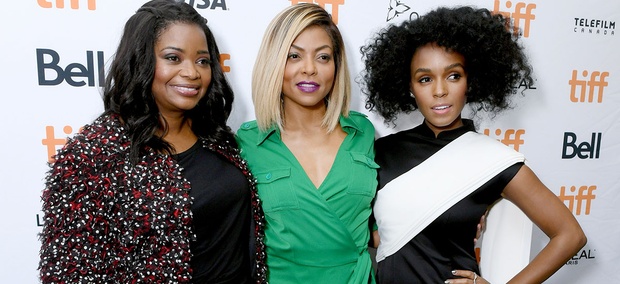Back in the 1940s and 1950s, computers were people, not machines. And one group of these human computers worked at a NASA research lab in southern Virginia. An upcoming movie, Hidden Figures, focuses on how three of these human computers helped with John Glenn’s historic first US orbital flight in 1962. As you probably know, Glenn died earlier this week at the ripe old age of 95.
 I haven’t yet seen the movie — it will be out in a few weeks. But the underlying story is terrific. The three human computers turn out to be three black women mathematicians, including Katherine Johnson (shown above) who recently received the Congressional Freedom Medal.
I haven’t yet seen the movie — it will be out in a few weeks. But the underlying story is terrific. The three human computers turn out to be three black women mathematicians, including Katherine Johnson (shown above) who recently received the Congressional Freedom Medal.
One of the interesting historical notes was Glenn insisted that Johnson check the electronic computer’s calculations of his orbit, to make sure they were accurate. This was back when computers filled rooms and were slower than the CPUs that are found in the average smartphone nowadays.
Johnson continued to work at NASA until 1986 combining her math talent with electronic computer skills. Her calculations proved critical to the success of the Apollo Moon landing program and the start of the Space Shuttle program, according to this NASA writeup.
 There are a lot more video interviews with both the actresses Octavia Spencer, Taraji Henson (who plays Johnson) and Janelle Monae (shown above) and the real people behind the story here at NextGov.
There are a lot more video interviews with both the actresses Octavia Spencer, Taraji Henson (who plays Johnson) and Janelle Monae (shown above) and the real people behind the story here at NextGov.
In addition to the movie, there is a book by Margot Lee Shetterly that just was published.Why did it take so long for this story to come out? Shetterly apparently learned about the achievements of these women computers from her father, who “casually mentioned it to her in an offhand comment,” according to Rudy Horne, a math professor at Morehouse College and a consultant to the movie production. Horne got involved because his college was used as a film location (the college campus is used to simulate the NASA Langley campus in southern Virginia where the story takes place), and the director wanted a real math professor to check his calculations. One of the wonderful coincidences is that the current NASA administrator and Horne himself are both African Americans.
Horne was brought on early in the production, before the script was finalized, to ensure that the math checked out. I called him and asked about his role. “In the beginning of the film, the young Johnson is shown solving a series of equations on a blackboard. They originally showed her solving a functional analysis problem, which is more of a college level math course. I suggested a set of quadratic equations, which would be more appropriate for a younger student.” Horne made several other suggestions for the sets and props to show other math formulas. When I asked him what his favorite math-themed movie was, he said, “Good Will Hunting got the math right and had very believable scenes that showed how math professors interact. I am glad that was a consultant to this movie, and it is great if it will inspire other students to study math and science.” As an undergrad math major, me too.
This episode of NBC’s “Timeless” also featured her: http://www.imdb.com/title/tt6209428/?ref_=ttep_ep8
NBC’s Timeless series also featured these facts and dramatized events in the latest episode of 12/4/16. Interesting it was taped and released just prior to John Glenn’s passing this week.
I loved the movie, and have not read the book yet. One of the things that surprised me was how the IBM employees installing the 7090 seemed to be in way over their heads. They could not even get the system up and running, let alone program it. Was this for entertainment value, or were they/IBM really that incompetent?
More details on the IBM 7090 computer featured in the movie here: http://www.zdnet.com/article/hidden-figures-and-the-ibm-7090-computer/